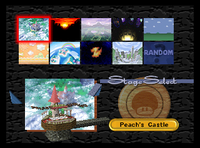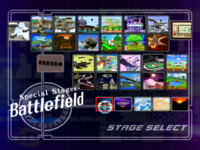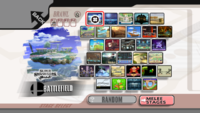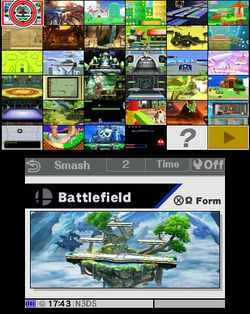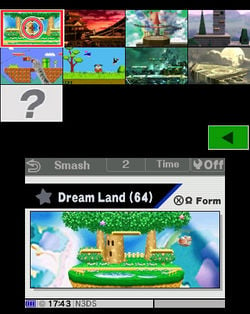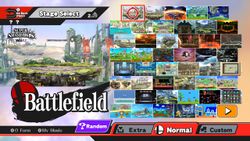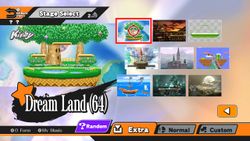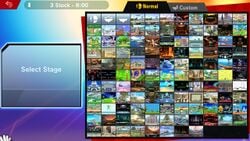Stage
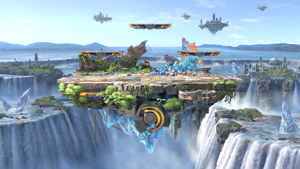
A stage (ステージ, Stage), also called a level, map, arena, stadium, or board, is a location in which characters fight or complete objectives. The word "stage" refers to a versus mode stage, but can also refer to the ground or large central platform within this location. As well as versus mode stages, single player mode stages, such as the Target Smash ones, exist for purposes other than fighting.
Versus stages
In all of the games of the Super Smash Bros. series, most versus mode stages are available from the start, while a small number must be unlocked by completing certain objectives. Some stages in SSB4 were made available through updates and are downloadable. Of these stages, only two are free. Most stages, like Princess Peach's Castle, are derived from places in playable characters' universes. Super Smash Bros. Melee introduced two Super Smash Bros. universe stages — Battlefield and Final Destination. In Super Smash Bros. Brawl, stages derived from games without associated playable characters were introduced, namely Smashville and Hanenbow, while PictoChat represents a Nintendo DS utility interface. Additionally, not every playable character has a stage from their own universe, the Fire Emblem universe lacked one in Melee (though one was planned), and the R.O.B. universe has, for unknown reasons, never had a stage. Included in all games other than the first are a small number (large number in Smash Wii U and Ultimate) of Past Stages — stages from a previous Smash game. These stages will have either no or minor alterations, an example being Dream Land (64) in SSB4, where the top blast line is much closer to the stage then it was in 64 or Melee. Ultimate changes this, giving various stages a more refined and detailed design.
Stages range in size from the large The Great Cave Offensive and Rumble Falls to the small Yoshi's Story and Peach's Castle. Typically, stages involve a large central platform with ledges, multiple smaller platforms, as well as blast lines above, below, and to the left and right of the visible area. Some stages, such as Mushroom Kingdom and Coliseum, have floors that continue past the edge of the visible area and pass through a side blast line, these edges are known as "walk-off edges" or "walk-offs", because characters can walk offscreen without the need to become airborne. Stages with walk-off edges on both the left and right, like Bridge of Eldin, are referred to as "walk-off stages", and only a select few, like Yoshi's Island, have only one walk-off. Some walk-off stages, such as Onett, have lower blast lines that are inaccessible normally, while others, such as Green Hill Zone, only infrequently have the lower blast lines introduced; still others, such as Mushroom Kingdom, have permanently-accessible gaps where players can fall past the lower blast line while still having solid ground covering most of the lower blast line, including its intersections with the left and/or right blast lines.
In Melee, moving and transforming stages were introduced. Big Blue and Rainbow Cruise consist entirely of platforms that move or appear on and offscreen, while stages like Icicle Mountain and PAC-LAND scroll continuously up, to the side, or down. Other stages, such as Pokémon Stadium, undergo partial transformations at certain intervals, while yet others, like Brawl's Castle Siege and Smash 3DS's Paper Mario, cycle through complete transformations. Similarly, stages like Delfino Plaza and Skyloft will take players to various areas via moving platforms. Mushroomy Kingdom may be one of two stages either randomly or based on a player's input prior to the match. Tortimer Island's, Gamer's, Balloon Fight's, and Garden of Hope's layouts are randomized to varying degrees for each battle as well.
Other stage elements include breakable barriers and platforms, such as the pillars of Luigi's Mansion and the stone floors of Skyworld; stage hazards and enemies, such as lasers, cars, and Klaptraps; local items such as apples; and interactive objects such as Barrel Cannons and switches. While water has no effect on movement in Melee outside of the flowing river in Jungle Japes, Brawl introduced swimming, and some of its stages involve water that can be swum in.
In Brawl and Smash 4, the appearance of some items, namely crates and barrels, differs depending on the aesthetic style of the stage they appear on.
In all games, some stages (and in SSB's case, all but one) are banned in competitive play because they are considered disruptive or unfair. See stage legality.
List of Stages
| Starter | Unlockable | Downloadable |
Notes
- ^ Listed as "Special Stages: Battlefield" in Melee.
- ^ Listed as "F-Zero Grand Prix: Big Blue" in Melee.
- ^ Listed as "Planet Zebes: Brinstar" in Melee.
- ^ Listed as "Planet Zebes: Brinstar Depths" in Melee.
- ^ Listed as "Lylat System: Corneria" in Melee.
- ^ Listed as "Past Stages: Dream Land" in Melee.
- ^ Listed as "Dream Land" in Smash 4.
- ^ Listed as "Mario Circuit" in Brawl, and as "Mario Circuit (Brawl)" in Smash 4.
- ^ Listed as "Special Stages: Final Destination" in Melee.
- ^ Listed as "Superflat World: Flat Zone" in Melee.
- ^ a b c d Appears as part of Flat Zone X.
- ^ Listed as "Dream Land: Fountain of Dreams" in Melee.
- ^ Listed as "Eagleland: Fourside" in Melee.
- ^ Listed as "Termina: Great Bay" in Melee.
- ^ Listed as "Dream Land: Green Greens" in Melee.
- ^ Listed as "Infinite Glacier: Icicle Mountain" in Melee.
- ^ Listed as "DK Island: Jungle Japes" in Melee.
- ^ Listed as "DK Island: Kongo Jungle" in Melee.
- ^ Listed as "Congo Jungle" in 64, and as "Past Stages: Kongo Jungle" in Melee.
- ^ Listed as "Mushroom: Kingdom" in Melee.
- ^ Listed as "Mushroom: Kingdom II" in Melee.
- ^ Listed as "F-Zero Grand Prix: Mute City" in Melee.
- ^ Listed as "Mute City" in Smash 4.
- ^ Listed as "Eagleland: Onett" in Melee.
- ^ Listed as "Mushroom Kingdom: Princess Peach's Castle" in Melee.
- ^ Listed as "Kanto Skies: Poké Floats" in Melee.
- ^ Listed as "Kanto: Pokémon Stadium" in Melee.
- ^ Listed as "Mushroom Kingdom: Rainbow Cruise" in Melee.
- ^ Listed as "Yoshi's Island" in 64, and as "Past Stages: Yoshi's Island" in Melee.
- ^ Listed as "Hyrule: Temple" in Melee.
- ^ Listed as "Lylat System: Venom" in Melee.
- ^ In Super Smash Bros. for Nintendo 3DS, Wily Castle is set during the day and has a variety of moving platforms.
- ^ In Super Smash Bros. for Wii U, Wily Castle is set during the night and has platforms moving along rails, as well as the Yellow Devil.
- ^ In Ultimate, Wily Castle is set during the night and has the hazards from both versions of Smash 4.
- ^ Listed as "Yoshi's Island: Yoshi's Island" in Melee.
- ^ Listed as "Yoshi's Island: Yoshi's Story" in Melee.
In Super Smash Bros.
There are nine versus stages in the original Super Smash Bros., eight starters and one unlockable stage: Mushroom Kingdom, shown in bold.
Congo Jungle
Dream Land
Hyrule Castle
Mushroom Kingdom
Peach's Castle
Planet Zebes
Saffron City
- File:StreetFighterSymbol(preBrawl).svg Sector Z
Yoshi's Island
In Melee
There are 29 versus stages in Super Smash Bros. Melee, 18 starters and 11 unlockable stages, shown below in bold. The three past stages are unlockable.
Battlefield
Big Blue
Brinstar
Brinstar Depths
- File:StreetFighterSymbol(preBrawl).svg Corneria
Final Destination
Flat Zone
Fountain of Dreams
Fourside
Great Bay
Green Greens
Icicle Mountain
Jungle Japes
Kongo Jungle
Mushroom Kingdom
Mushroom Kingdom II
Mute City
Onett
Poké Floats
Pokémon Stadium
Princess Peach's Castle
Rainbow Cruise
Temple
- File:StreetFighterSymbol(preBrawl).svg Venom
Yoshi's Island
Yoshi's Story
In Brawl
There are 41 versus stages in Super Smash Bros. Brawl, 29 starters and 12 unlockable stages, shown below in bold. None of the original Super Smash Bros. stages return, but there are 10 stages from Melee, one from each universe involved in the original Super Smash Bros.
75m
Battlefield
Bridge of Eldin
Castle Siege
Delfino Plaza
Distant Planet
Final Destination
Flat Zone 2
Frigate Orpheon
Green Hill Zone
Halberd
Hanenbow
Luigi's Mansion
Lylat Cruise
Mario Bros.
Mario Circuit
Mushroomy Kingdom
New Pork City
Norfair
PictoChat
Pirate Ship
Pokémon Stadium 2
Port Town Aero Dive
Rumble Falls
Shadow Moses Island
Skyworld
Smashville
Spear Pillar
Summit
WarioWare, Inc.
Yoshi's Island
Big Blue
Brinstar
Corneria
Green Greens
Jungle Japes
Onett
Pokémon Stadium
Rainbow Cruise
Temple
Yoshi's Island
In Smash 4
Stages in Super Smash Bros. 4 differ depending on the version. Super Smash Bros. for Nintendo 3DS features 42 stages total, 7 of which are unlockable, shown in bold, and 8 of which are downloadable content. Super Smash Bros. for Wii U features 55 stages, 6 of which are unlockable, shown in bold, and 9 of which are downloadable content. Bold and italic text denotes stages that are unlockable in one version, but a starter/downloadable stage in the other. 13 stages appear in both versions (with some having changes), however the majority of stages are exclusive to each version, with 3DS stages primarily pulled from handheld games and Wii U stages from console games (though, there are some exceptions). In addition, this is the first game where stages from all the past entries return at once.
All stages now have an optional Ω form (Omega Form), changing their layout to be similar to Final Destination - some have walls that go all the way down to the bottom blast line, while others are basically floating islands.
Unique to Smash 4 is the disabling of Star KOs and Screen KOs on certain stages.
| Starter | Unlockable | Downloadable |
In Ultimate
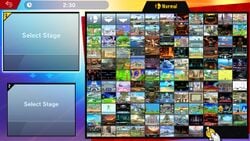
There will be 108 versus stages in Super Smash Bros. Ultimate with five being future downloadable content. Many stages return from all the previous games, although not every stage from previous titles will be returning.[1] Of the stages confirmed in Ultimate, 7 are unique to Ultimate and 96 are familiar stages: 7 from Super Smash Bros., 19 from Super Smash Bros. Melee, 26 from Super Smash Bros. Brawl, and 44 from Super Smash Bros. 4 (18 from the 3DS version, 18 from the Wii U version, and 8 that are in both versions). Ω forms return for each stage, along with a new Battlefield form for every stage. All Battlefield and Ω forms have the same size and terrain as Battlefield and Final Destination, respectively. Up to 8 players are supported on every stage.
There are only 15 stages that do not return in Smash Bros Ultimate ; 2 from SSB64 (Planet Zebes and Sector Z), 4 from Melee (Icicle Mountain, Mute City, Mushroom Kingdom and Poké Floats), 2 from Brawl (Rumble Falls and PictoChat), 2 from Smash for 3DS (Rainbow Road and Pac-Maze), and 5 from Smash for Wii U (Miiverse, Woolly World, Orbital Gate Assault, Jungle Hijinxs and Pyrosphere).
A new rules option allows stage hazards to be turned off. Stages are ordered by when they first appeared in the Super Smash Bros. series. Unlike previous entries, all stages are available from the start. Ultimate also introduces Stage Morph, an option which allows players to choose two different stages which will transition back and forth over the course of a battle.
Ultimate Stages
Battlefield
Big Battlefield
Dracula's Castle
Final Destination
Great Plateau Tower
Moray Towers
New Donk City Hall
Familiar Stages
 Dream Land
Dream Land Peach's Castle
Peach's Castle Hyrule Castle
Hyrule Castle Kongo Jungle
Kongo Jungle Mushroom Kingdom
Mushroom Kingdom Saffron City
Saffron City Yoshi's Island
Yoshi's Island Big Blue
Big Blue Brinstar
Brinstar Brinstar Depths
Brinstar Depths Corneria
Corneria Fountain of Dreams
Fountain of Dreams Fourside
Fourside Great Bay
Great Bay Green Greens
Green Greens Jungle Japes
Jungle Japes Kongo Jungle
Kongo Jungle Mushroom Kingdom II
Mushroom Kingdom II Onett
Onett Pokémon Stadium
Pokémon Stadium Princess Peach's Castle
Princess Peach's Castle Rainbow Cruise
Rainbow Cruise Temple
Temple Venom
Venom Yoshi's Island
Yoshi's Island Yoshi's Story
Yoshi's Story 75m
75m Bridge of Eldin
Bridge of Eldin Castle Siege
Castle Siege Delfino Plaza
Delfino Plaza Distant Planet
Distant Planet Frigate Orpheon
Frigate Orpheon Green Hill Zone
Green Hill Zone Halberd
Halberd Hanenbow
Hanenbow Luigi's Mansion
Luigi's Mansion Lylat Cruise
Lylat Cruise Mushroomy Kingdom
Mushroomy Kingdom Mario Bros.
Mario Bros. New Pork City
New Pork City Norfair
Norfair Mario Circuit
Mario Circuit Pirate Ship
Pirate Ship Pokémon Stadium 2
Pokémon Stadium 2 Port Town Aero Dive
Port Town Aero Dive Shadow Moses Island
Shadow Moses Island Skyworld
Skyworld Smashville
Smashville Spear Pillar
Spear Pillar Summit
Summit WarioWare, Inc.
WarioWare, Inc. Yoshi's Island
Yoshi's Island Boxing Ring
Boxing Ring Duck Hunt
Duck Hunt Gaur Plain
Gaur Plain Midgar
Midgar Super Mario Maker
Super Mario Maker Suzaku Castle
Suzaku Castle Umbra Clock Tower
Umbra Clock Tower Wily Castle
Wily Castle 3D Land
3D Land Arena Ferox
Arena Ferox Balloon Fight
Balloon Fight Dream Land GB
Dream Land GB Find Mii
Find Mii Gerudo Valley
Gerudo Valley Golden Plains
Golden Plains Living Room
Living Room Magicant
Magicant Mute City SNES
Mute City SNES Paper Mario
Paper Mario PictoChat 2
PictoChat 2 Prism Tower
Prism Tower Reset Bomb Forest
Reset Bomb Forest Spirit Train
Spirit Train Tomodachi Life
Tomodachi Life Tortimer Island
Tortimer Island Unova Pokémon League
Unova Pokémon League Coliseum
Coliseum Gamer
Gamer Garden of Hope
Garden of Hope Flat Zone X
Flat Zone X Kalos Pokémon League
Kalos Pokémon League Mario Circuit
Mario Circuit Mario Galaxy
Mario Galaxy Mushroom Kingdom U
Mushroom Kingdom U Pac-Land
Pac-Land Palutena's Temple
Palutena's Temple Pilotwings
Pilotwings Skyloft
Skyloft The Great Cave Offensive
The Great Cave Offensive Town and City
Town and City Wii Fit Studio
Wii Fit Studio Windy Hill Zone
Windy Hill Zone Wrecking Crew
Wrecking Crew Wuhu Island
Wuhu Island
Single player stages
In the single player modes and challenges, a number of stages appear that are not available in versus mode.
- The Home-Run Contest stages in Melee, Brawl, and SSB4 involve a central platform from which Sandbag is hit, and a very long stretch of ground to the right of the platform for it to land upon.
- In Melee's "trophy tussle" event matches, the player fights CPUs upon a stage that takes the form of a giant object, the trophy for which he or she wins after completing the event.
- The original Super Smash Bros. Board the Platforms stages function as agility tests, and there are 12 in total - each one is designed to challenge the player's character.
- Like Board the Platforms, Break the Targets and Target Test stages of the original Super Smash Bros. and Melee respectively are tailored to challenge each character - 12 exist in the original and 25 in Melee. Some of Melee's Target Test stages are decorated in reference to their character's universe; Pikachu's, for example, has decorative Poké Balls in its walls, while the Ice Climbers' look like a level from the game Ice Climber. Brawl, however, simply has five Target Smash! stages for all characters, each representing a different difficulty level.
- Areas in Adventure Mode and the Adventure Mode: The Subspace Emissary are technically defined as stages.
- The Online Practice Stage in Brawl and SSB4 is playable only while waiting for an online match to load.
- The controls test stage in Brawl and SSB4 is playable only for the purpose of testing custom controls, and only as Mario.
In Super Smash Bros.
- Battlefield
- Board the Platforms stages
- Final Destination
- Meta Crystal
- Race to the Finish
- Target Test stages
In Melee
- Adventure stages
- All-Star Rest Area - The stage the players are teleported to and from between All-Star Mode matches.
- Entei - the stage on which Event 26: Trophy Tussle 2 is played.
- Goomba - the stage on which Event 14: Trophy Tussle 1 is played.
- Home-Run Stadium
- Majora's Mask - the stage on which Event 47: Trophy Tussle 3 is played.
- Race to the Finish - a Classic Mode bonus game stage.
- Snag the Trophies stage - a Classic Mode bonus game stage.
- Target Test stages - a set of single player mode stages that also appear in Classic Mode as bonus games.
In Brawl
- Adventure Mode: The Subspace Emissary stages
- All-Star Rest Area - The stage the players are teleported to and from between All-Star Mode and Boss Battle matches
- Controls Test stage
- Home-Run Stadium
- Online Practice Stage
- Target Smash! stages - a set of single player mode stages that also appear in Classic Mode as bonus games.
In Smash 4
Note: In the Wii U version, most of these stages can be played with two players.
- The Credits - A small stage where the player smashes names to reveal a picture.
- Trophy Rush stage - Raining blocks appear on the stage. If they are too far up, the stage will disappear and KO the player.
- All-Star Rest Area
- Home-Run Stadium
- Target Blast Stadium - A stage similar to the Home-Run Stadium. The player breaks the targets by smashing a bomb at them.
- SSB4's Online Practice Stage - Same as Brawl, but the Wii U version looks like an Ω form of the Miiverse stage with a Sandbag; the 3DS version's shape bears more of a resemblance to Ω Battlefield, but with different and simpler textures.
- SSB4's control test stage - Same as Brawl.
Non-playable stages
Some stages exist, but are non-playable; developers did not intended for them to be played in. Non-playable stages are accessible only through hacks and debug programs, such as Action Replay. Some, such as "Test", are assumed to have been used for testing during game development, while others, such as the "Tutorial stage", are used in the game but not for the purpose of gameplay.
In Super Smash Bros.
In Melee
In Brawl
- 1-Player Mode Credits - the file name of the single player mode credits is "STGCHARACROLL.pac", which technically defines it as a stage.
- Results Screen - the results screen that appears after a match is a stage, playable only through hacking.[2]
In for Wii U
- Photo Studio backgrounds - The backgrounds are all considered separate stages, and can only be played by hacking.
Custom Stages
Brawl introduced the Stage Builder, a tool that allows players to build their own stages, for use in multiplayer matches, using sets of provided objects, some unlockable. Brawl includes a set of Sample Stages that were built using the Stage Builder. The stage builder can also be used to build No KO stages and "CD Factories" - exploitative stages used for quickly obtaining CDs. The Stage Builder returns in Super Smash Bros. for Wii U, with some features removed and other features added.
References
| Stages in Super Smash Bros. | |
|---|---|
| Starter stages | Congo Jungle · Dream Land · Hyrule Castle · Peach's Castle · Planet Zebes · Saffron City · Sector Z · Yoshi's Island |
| Unlockable stage | Mushroom Kingdom |
| Stages in Super Smash Bros. Melee | |
|---|---|
| Starter stages | Brinstar · Corneria · Fountain of Dreams · Great Bay · Green Greens · Icicle Mountain · Jungle Japes · Kongo Jungle · Mushroom Kingdom · Mute City · Onett · Pokémon Stadium · Princess Peach's Castle · Rainbow Cruise · Temple · Venom · Yoshi's Island · Yoshi's Story |
| Unlockable stages | Battlefield · Big Blue · Brinstar Depths · Final Destination · Flat Zone · Fourside · Mushroom Kingdom II · Poké Floats |
| Dream Land · Kongo Jungle · Yoshi's Island | |
